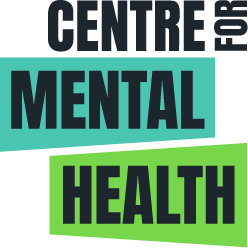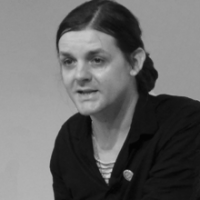
By Mark Brown
Listen to Mark Brown reading the full piece here
Part 1: Mental Health Social Media Made Me
In mental health we are often terrible at recognising the future as it is happening. Despite living in an age of Five Year Forward Views, Mental Health Act Reviews and Ten Year Plans, mental health as an overall area of human enterprise finds it difficult to picture any future that isn’t like now but more. My job as someone who writes and thinks about mental health is to look at the unfolding now and to see where the future might be hidden within it.
To think about the future we need to be able to see where we have come from; to reach backwards to understand how things came into being and what came before them. The future doesn’t arrive in orderly ways. It arrives uncomfortably and unannounced; elbowing you in the ribs and sitting in your favourite chair. It arrives in gaps and awkward pauses; in talking at cross purposes and in arguments. It arrives in last thoughts before sleep that grip your heart like an icy hand and in the things you see out of the corner of your eye when you’re trying to concentrate on something else.
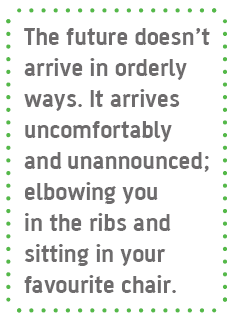
I’ve been writing and thinking and doing in mental health since 2006 when I began the development of One in Four magazine, a national magazine written by people with mental health difficulties for people with mental health difficulties. Before that I was someone who experienced mental health difficulties and I still am. I’ve got three A- levels. No degree. No professional qualifications or mental health profession. I didn’t learn mental health from books or from academia, despite having a passion for learning from both. Without a space to explore what it meant to be me in the world I got good at telling my story; but without anything to bounce off I never saw how sharing my experience wasn’t the end of something but the beginning of something else. I spent years telling my story in different ways to different people; like flashing a lamp from a hillside hoping for answering light from across the valley that never came. Then something changed.
I found my way in mental health by finding others living through mental health difficulty and distress themselves. How did I do that? I took part in the future as it was arriving. In the days before IAPT, before endless amounts of articles about mental health, before easy access to online information and social media platforms was something that huge amounts of people would take part in, I was lucky enough to find the world of mental health blogs and it changed the course of my life.
I’m not really sure how I found the secret infrastructure of mental health blogs. Most probably by googling “mental health” or similar late on some night in 2004, sitting in front of the boxy monitor of the desktop PC I’d borrowed from work.
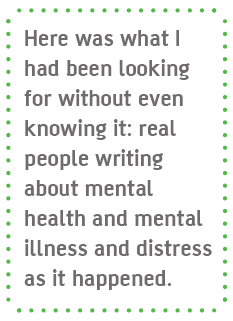
Suddenly, as if stumbling into a clearing in the middle of a dark wood, here was space and light and perspective. Here was what I had been looking for without even knowing it: real people writing about mental health and mental illness and distress as it happened. Some blogs sang with poetry and glorious words; others with bluntness and awkwardness; others still with a kind of analytic exuberance that tried to make new shapes from old experiences and to put together ideas in ways that I’d never seen. Some of these bloggers were mental health professionals. Most weren’t.
Each blog either existed in isolation or was linked to other blogs via buttons and badges which linked it on to others. Sometimes these blogs would have blogrolls of other sites which its author also liked. Other times interesting comments on particular pieces led you to the blog of the author. People fed upon each other, interacted with each other. Between the blogs, between the authors, something was being built, a kind of shared sense of what was happening. Many of the blogs are gone now, swallowed by the ephemeral and volatile nature of online life. They weren’t meant to last forever. They were meant to last as long as their authors needed them to last, running until there was nothing more to say.
Many of these blogs were anonymous, existing under cute nicknames and non-deplumes, a tradition that continues today through people’s use of twitter and other online platforms to speak about mental health. Some of the people are gone now. Some I count as friends. Others I see online from time to time in different places with different names and different projects.
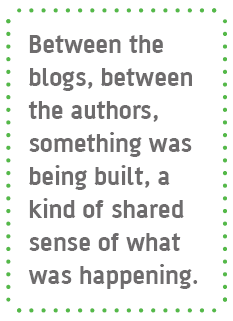
It was these blogs that taught me how to understand and think about mental health; gave me the chance to grow up in the company of my peers; helped me to see that not everyone saw their distress in the same ways. People with the same experiences had widely different views of what those experiences meant. This secret school carried out in public helped me to see that mental health wasn’t a topic at all but an infinite range of topics tied together only by an arbitrary set of taxonomies; and, far more importantly, that those topics crossed over the boundaries of the lives of people who experienced mental health difficulty.
In the way that journalism is described as the first draft of history, online discussion about mental health between people who live with it is like the first draft of an infinite number of possible new understandings of mental health. What I found in the blogs of the first decade of the twenty-first century I now find in the ever-growing; ever-chaotic, ever-surprising world of social media.
Part 2: Being together to share the unsayable
It’s easy to minimise how transformative the shared spaces of mental health social media are to those who take part, and even easier to minimise how the products of these spaces are changing understandings of mental health from outside of the academy and the professions.
Social media has created an historically novel situation for mental health by providing three things:
- Persistent public discussions that can be joined by anyone and consumed by anyone
- A space distinct from academic, policy or medical discourse where mental health, mental illness and associated topics can be discussed
- A space where life with mental health difficulty can be lived in the presence of others also living with the effects and experiences that mental ill health and distress brings.
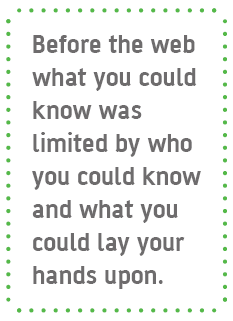
The overwhelming majority of you will be reading this on a computer or phone screen. Some of you will have found it through social media. Some of you because you follow Centre for Mental Health. Some of you because I’m part of your day to day life via twitter. This is novel in itself. Most of you will have never met me. Some of you will have never heard of me. Yet somehow these words have reached you.
Before the web what you could know was limited by who you could know and what you could lay your hands upon. Books and journals were like treasures in a dungeon quest; hidden in the darkness until a brave adventurer could plunder them and carry them as trophies back to the people of the village.
We think of online discussion between people with mental health difficulties as being eternally new and still talk about it as if it were the future. It’s easy to forget that our modern conception of mental health conversation is inextricably tied to the development of social media as an omnipresent part of many of our lives. The first iPhone only launched in the UK in 2007, around the same time that 3G mobile made it possible to browse the web and exchange richer media via mobile devices. I joined twitter in 2009. While we were looking elsewhere the future was arriving and once it was here we assumed it had been around forever.
Lived experience of mental health difficulty is a category created to to distinguish the lives that people live and the ideas they have as a result, from the professional knowledge held by institutions, practitioners and researchers. While those institutions racked their brains as to ways they stimulate and include ‘lived experience’ in their professional knowledge – creating sweeping and seldom executed plans for engagement and inclusion – people with mental health difficulties were getting on with creating a public discussion without them. Right now, on social media, discussion about the realities of life lived with distress and mental ill health is happening in ways and in volume that seemed impossible a decade ago.
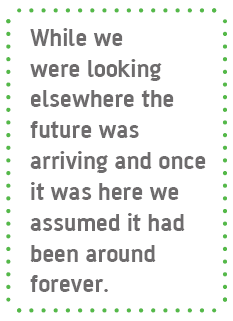
Social media (and by extension the entire online realm) did not feature at all in the first iteration of the multimillion pound mental health anti stigma campaign Time to Change. Instead the focus was on physical stunts, cinema ads and print media coverage. The largest show in town as the planning was taking place to launch Time to Change was the BBC’s Headroom campaign; with TV and radio programming and online resources to read and watch, but few, if any, with which to interact.
Our growing space for online discussion of mental health, mental illness and distress is a massive change for the overall world of mental health. Not because ‘more people are talking’ and ‘changing attitudes’; but because for the first time ever, people who experience mental health difficulties can find each other regardless of geographical boundaries or the limits that living with ongoing distress and difficulty can place upon someone’s ability to meet others. And it is through meeting others in a realm of ideas and experiences and discussion that the real transformation is occurring. The experience of those who live with mental health difficulties is disruptive and difficult to situate within discourse because it cannot make the choice to respect boundaries, cannot choose to stay in its lane. It spills all over the place; brings the wrong problem to the wrong door; makes what seemed simple appear complicated; refuses to conform to the logic to which the demands of professions and research place upon it.
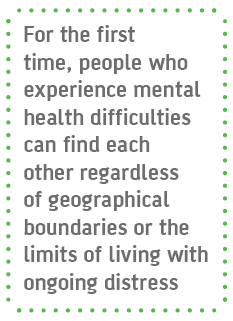
Mental health difficulty as lived is not the same as mental health difficulty defined, and is often different from what is researched. And now, for the first time, it’s possible to see in real time how great that disparity is. Social media has provided a new space where people with mental health difficulties can discuss with others in public what they may never have found the space or safety to even discuss with those closest to them in private. Finding spaces where what would have been unsayable is easily understood; people can move from explaining their own experience to a potentially hostile or uncomprehending audience of family and friends, to considering with others who ‘get it’ what that experience means.
The net result of this communal space of lived experience has been to accelerate discussion of mental health, but more than that, it has made discussion possible that can be taken up by those not present when it was initially occurring. This has made it possible for responses to evolving realities around mental health to travel far beyond the kinds of mental health activism that had existed prior to the coming of social media. This shift to shared spaces of common understanding has resulted in the birth of what might be called a mental health public opinion; where people have begun to differentiate from each other based on their own ideas and approaches to mental health and distress as an issue, not just an experience. A recent paper by Diana Rose, A Hidden Activism and its Changing Contemporary Forms: Mental Health Service Users / Survivors Mobilising in The Journal of Social and Political Psychology captures some of the ways in which the shared discursive space created by social media is making possible ‘hidden activisms’ resulting in part from people coming together via social media.
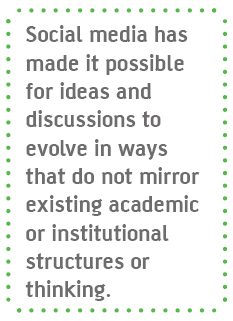
Social media has created a persistent environment where themes and experiences can be explored by a range of people who do not know each other. In the same way that mental health blogs in 2004 allowed me an access to debate and thinking and new information and perspectives, social media has made it possible for ideas and discussions to evolve in ways that do not mirror existing academic or institutional structures or thinking.
Social media is one of the places where people who experience mental health difficulties can break free from the boxes into which they are placed by received wisdom and institutional practice. Breaking free together can be both liberating and frightening, but the two are impossible to separate. Now people are getting together, lived experiences and ideas about mental health are clashing and cross-pollinating. The shoots of new understandings and ideas are rising in ways that suggest new, challenging, futures.
Part 3: What came before mental health social media and what might come next?
We are living through the age of great disruption where it is possible to see not just how social media affects those who engage in it but also everything and everyone around it whether they are active users or not. Discussion of social media and mental health has tended to focus on the mental health impacts of technology rather than the effect social media has on mental health as an area of experience and ideas.
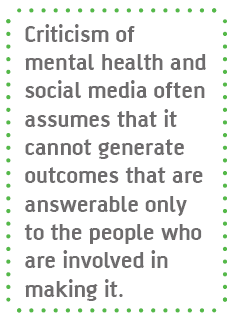
The stock response from gatekeepers of knowledge or power to the growth of social media in people’s lives is to see it from the outside; to survey it as if from a high peak and to judge it through its usefulness for other activities and imperatives. Regarding social media and mental health, the criticism will be that it is not representative; may not be honest or authentic; may encourage bad actions as well as good; is just a race to the bottom of acting out and showing off. Criticism of mental health and social media often assumes that it cannot have intrinsic value or generate outcomes that are answerable only to the people who are involved in making it. Most discussion of mental health social media assumes it must be answerable to some purpose beyond itself. As an autonomous space for the development of shared conclusions and shared analysis, social media presents an environment where the collective ideas of people who experience mental health difficulties can grow and shift and hash out new positions and new understandings. The self-image and self-determination of people with lived experience will increasingly deviate from the institutional discourses which have previously defined debates around the future of mental health. Where lived experience can find fellow feeling, it will grow in confidence and in the clarity of the demands it makes of society.
Similar social media accelerated processes can be seen in everything from autistic people’s political self-assertion to the #MeToo movement and Black Lives Matter. Social media as the space for strangers to be together and to find common cause and common issues has, both for good and ill, become a defining element of the modern political landscape. This accelerated aggregation of experience and ideas between people dispersed by geography and circumstance who have experienced marginalisation, violence and prejudice has created real external pressure for change upon existing institutions and social practices. The mechanisms are at work in external pressures; both for social changes we feel are distasteful as well as ones with which we feel kinship.
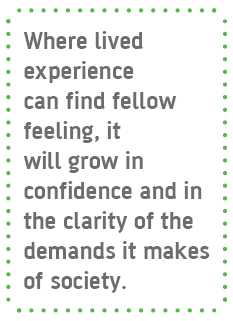
In many ways, prior to the web, the possibility that our own story as a person with mental health difficulties could be part of a larger story shared with others was an experience reached only by luck or misfortune. Often people only came into the company of others with similar experiences through the shared experience of treatment, time in hospital or through the spaces provided by certain charities or initiatives. The coming together and the comradeship and fellow feeling were often wrapped up as part of the same event or experience. Medical and scientific ideas about mental health remained most powerful because people in those professions met more people who lived through distress and mental ill-health in a month than most people who lived through the same met in a lifetime. Professionals saw us as a group but we seldom saw each other at all enough to challenge their idea of what our group meant.
The history of lived experience, and the work of changing the world informed by that experience, was made by the small number of people who had been lucky enough to find each other, a tiny island that featured on the maps only of the few lucky enough to be lost enough to find it by accident. The lived experience of other people with mental health difficulties was limited to small glimpses; an article here, a quote there. The ongoing reality of others’ life with mental health difficulty never felt like comforting background hum of familiar conversation. Never present for long, it was reduced to scrapbooks of clippings in lofts or yellowing papers and never-sent letters stuffed in drawers; more like a few brief handclaps in the night or a half-heard conversation through an open window. We built our own personal cosmologies to explain and contextualise to ourselves and others the experiences with which we lived daily; stitching together tapestries from popular films, soap operas, celebrity autobiographies, newspaper gossip and dusty old paperbacks and textbooks from the library.
As atomised individuals living with mental health difficulty we moved through our experiences like detectives, sure that something had happened somewhere but with no clues or leads to follow. Knowledge and ideas and understanding followed set paths. Unless you met the right people or found the right book or newspaper or magazine, knowledge and ideas remained forever out of view, a secret club into which you had to be inducted step-by-step. Only if you were lucky enough to find the gap in the fence that led through to the secret garden did you ever know there was anything else on the other side of the high hedges of accepted ideas and opinions. We often lived our distress and experience and difference from those around us as a kind of second, hidden life; never knowing if anyone around us was carrying a secret past or present themselves. We lived and we suffered and we died never finding a home for this other story of ourselves. In this isolation, our insights, our experiences, our ideas were like beautiful plants turned to dry leaves and rot when we were no longer there to tend them.
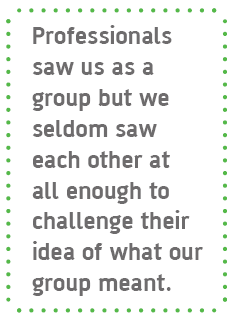
All futures are in flux. There are possible futures and probable ones. For those that live with mental health difficulty and distress, and those that care about them and find common cause, the objective must be to decide the preferred future for this newly opening space within which ideas, opinions and information circulate. Each week more people join. Each week more people realise the positions about mental health to which they feel closer and which ones they feel antipathy towards.
Previously, the creation of discourse about mental health as a specialist area of interest lay primarily in broader social attitudes, followed by professional attitudes and then a very distant third were a small cadre of people with lived experience. Social media has shaken that settlement up in ways that are both glorious and uncomfortable for all involved.
It’s in our hands to make the mental health social media that we want to see. How we conduct our lived experience in social media will shape the future of ideas about mental health. But we’re unsure, worried, afraid. There’s so many of us now, all making mental health things happen on people’s screens and in people’s pockets and bags.
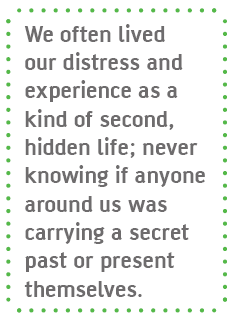
But the most important things we make happen on social media are in people’s heads, our own heads included.
Lived experience of mental health difficulty has found a home across social media, and in ways that are challenging what has come before. It’s not the sum total of all lived experience, but it is the total of the experience of the people present in any conversation, any individual piece of media, in any decision to share or comment on the ideas of others.
Finding other people who lived with mental health difficulty and distress online changed my life. It continues to change my life every day. It was people with mental health difficulties using social media that made me. Collectively we are making something and somewhere for the future that has never existed before.
These pieces are part of our writer in residence programme, and are the writer’s personal views.
